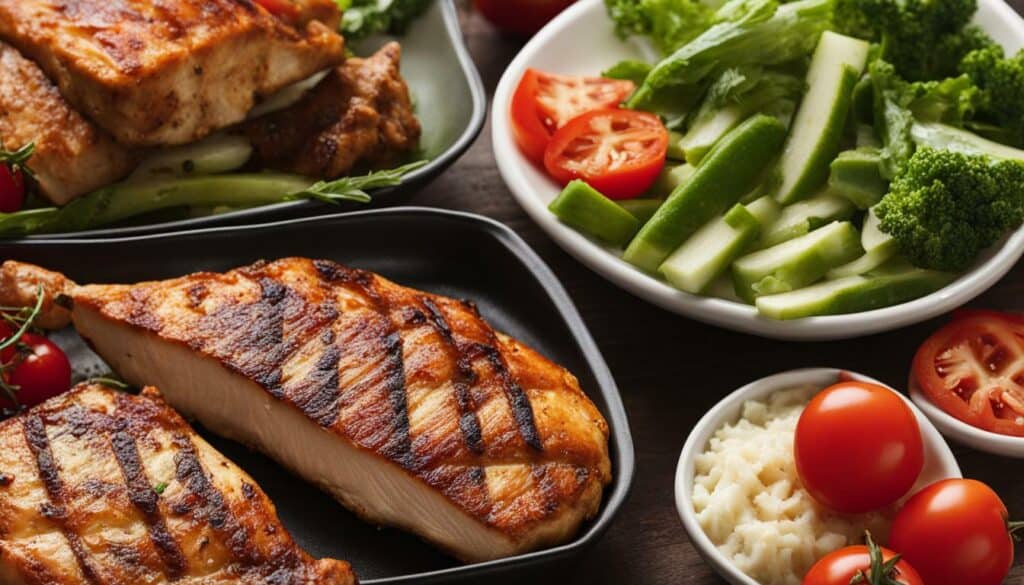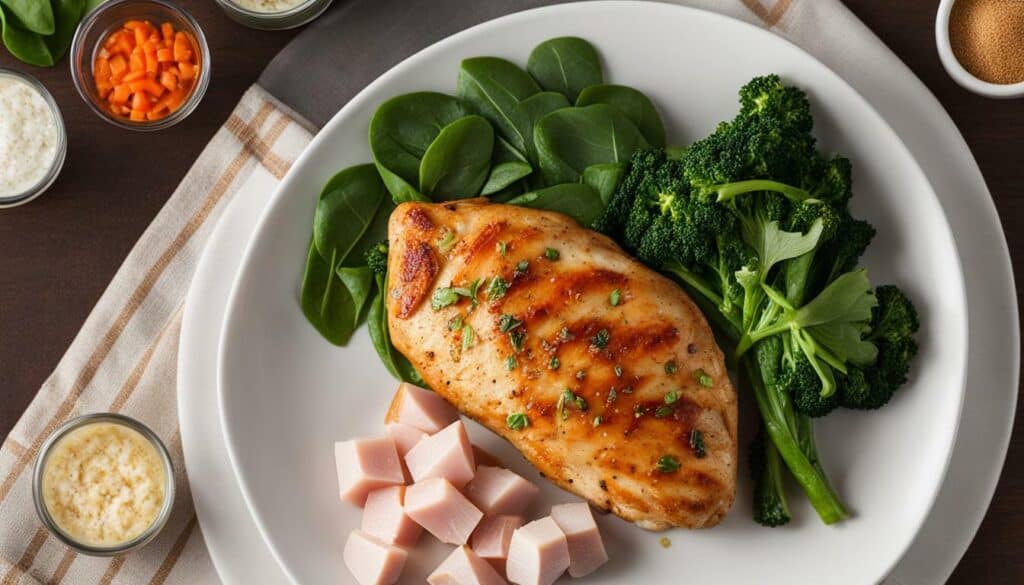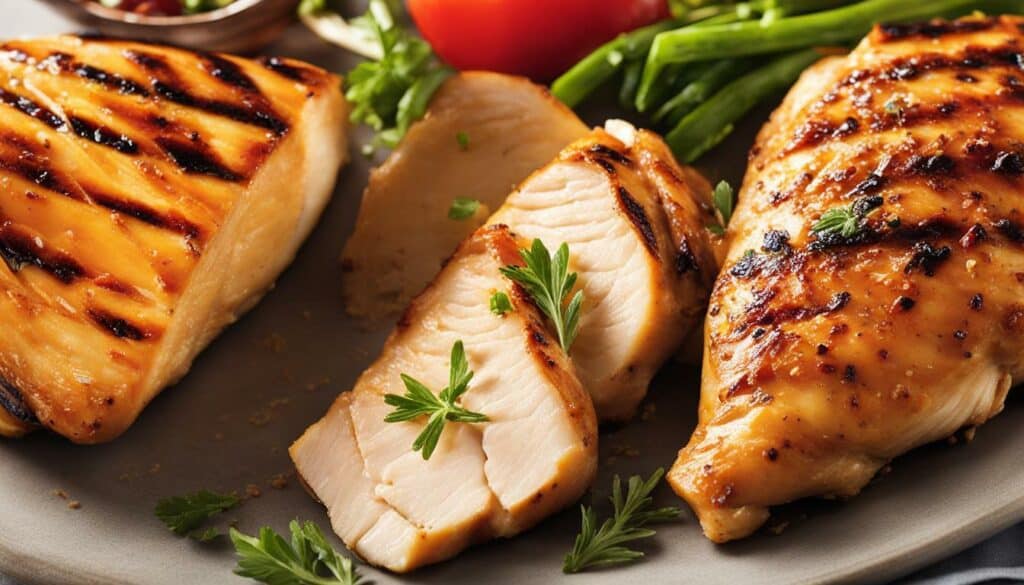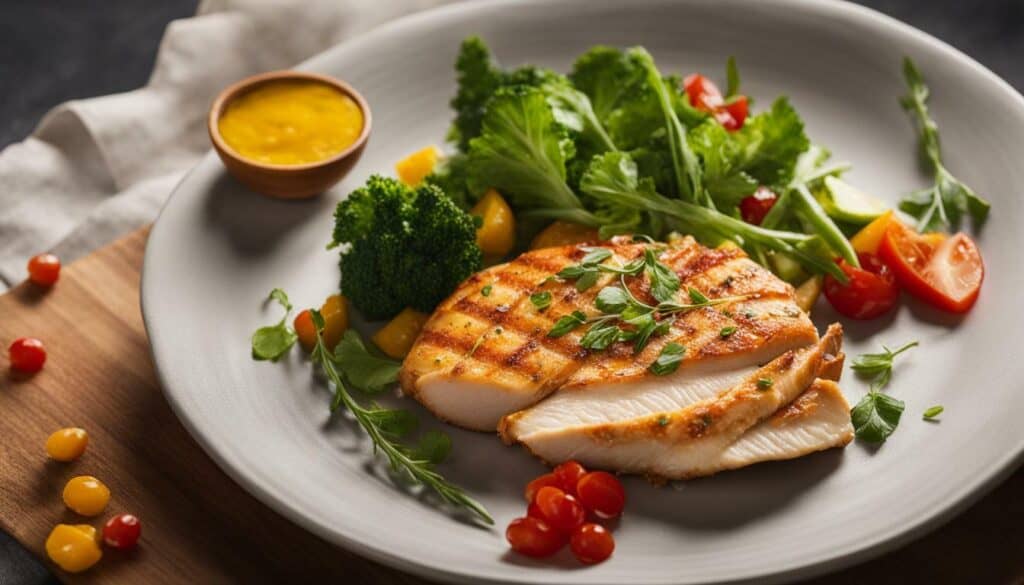Are you curious about how many calories are in a 2 oz serving of chicken breast? When it comes to maintaining a healthy diet, it’s essential to have accurate nutritional information. In this section, I will provide you with the precise calorie count for a 2 oz chicken breast, along with some important considerations about portion sizes and cooking methods.
- A 2 oz serving of boneless, cooked, skinless chicken breast contains approximately 77 calories.
- Chicken breast is a great source of lean protein and low in fat, making it beneficial for weight loss.
- Other cuts of chicken may have different calorie counts, so it’s important to be aware of the differences.
- The calorie content can increase if the chicken is cooked with the skin or prepared with high-fat ingredients.
- Choosing skinless chicken breast and utilizing healthy cooking methods like grilling or baking can help keep the calorie count low.
Chicken Breast Nutrition Facts
Before we delve into the specific calorie count, let’s first understand the overall nutrition profile of chicken breast. Chicken breast is a popular choice for its high protein content and low fat content. It is a lean meat that provides essential nutrients required for overall health and well-being.
One serving of boneless, cooked, skinless chicken breast, typically weighing around 2 ounces, contains approximately 77 calories. This makes it a favorable option for those aiming to lose weight or maintain a healthy lifestyle. Besides being low in calories, chicken breast is also a good source of essential vitamins and minerals.
| Nutrient | Amount per 100g |
|---|---|
| Protein | 31g |
| Fat | 3.6g |
| Selenium | 48.7mcg |
| Phosphorus | 210mg |
| Vitamin B6 | 0.84mg |
| Niacin | 14mg |
These nutrients are important for various bodily functions, including supporting muscle growth and repair, aiding in metabolism, and boosting immune health. Chicken breast also contains essential amino acids that promote cell development and improve overall body composition.
When considering different cuts of chicken, it’s important to note that the calorie content can vary. Other cuts such as thighs, wings, and drumsticks have higher fat content and may contain more calories. It’s essential to choose skinless chicken breast and opt for healthy cooking methods such as grilling or baking to keep the calorie count low.

Now that we understand the nutrition facts of chicken breast, let’s talk about serving size. The recommended serving size for chicken breast is about 3 to 4 ounces, which is roughly the size of a deck of cards. This portion allows you to incorporate an adequate amount of protein into your meals while keeping the calorie intake in check.
By being mindful of portion sizes and choosing lean cuts like chicken breast, you can enjoy a nutritious and delicious protein source that supports your health and fitness goals.
Calories in 2 oz Chicken Breast
It’s time to uncover the exact number of calories you can expect in a 2 oz serving of chicken breast. When it comes to managing your diet and making informed choices about your nutritional intake, having accurate information is key. So, let’s take a closer look at the calorie count of this popular protein source.
A 2 oz serving of boneless, cooked, skinless chicken breast contains approximately 77 calories. This makes chicken breast a low-calorie option that can be beneficial for weight management. It’s important to note, however, that the actual calorie content can vary depending on factors such as the size of the chicken breast and the cooking method used.
To put things into context, let’s compare the calorie count of chicken breast to other cuts of chicken. While chicken thighs, wings, and drumsticks may offer different flavors and textures, they also come with varying calorie counts. For example, a 2 oz serving of chicken thigh has about 109 calories, while the same amount of chicken wing contains around 103 calories. By choosing skinless chicken breast, you can enjoy a leaner option with fewer calories.
| Chicken Cut | Calories per 2 oz Serving |
|---|---|
| Chicken Breast | 77 |
| Chicken Thigh | 109 |
| Chicken Wing | 103 |
It’s worth noting that the calorie count can increase if the chicken is cooked with the skin or prepared using high-fat ingredients. By opting for skinless chicken breast and choosing healthy cooking methods like grilling or baking, you can keep the calorie content low while still enjoying a delicious and nutritious meal. Remember, portion control is also important, so be mindful of the serving size to maintain a balanced diet.

Chicken Breast Nutritional Value
Chicken breast offers more than just protein and calories – let’s take a closer look at its nutritional value. It is a lean source of meat that provides essential nutrients needed for overall health and well-being.
One of the key nutritional benefits of chicken breast is its high protein content. Consuming protein is vital for building and repairing tissues, supporting immune function, and maintaining healthy hair, skin, and nails. A 2 oz serving of boneless, cooked, skinless chicken breast contains approximately 16 grams of protein.
In addition to protein, chicken breast is rich in several important vitamins and minerals. It is a good source of selenium, a powerful antioxidant that helps protect the body against oxidative damage. Phosphorus is another mineral found in chicken breast, playing a key role in maintaining healthy bones and teeth. Vitamin B6, also known as pyridoxine, aids in brain development and function, while niacin supports energy metabolism.
| Nutrient | Amount per 2 oz serving |
|---|---|
| Protein | 16g |
| Selenium | 29.3 mcg |
| Phosphorus | 146 mg |
| Vitamin B6 | 0.4 mg |
| Niacin | 5.8 mg |
It’s worth noting that the calorie count and nutritional value of chicken breast can vary based on factors such as the method of cooking and whether or not it is prepared with the skin. For a healthier option, it is recommended to choose skinless chicken breast and use cooking methods like grilling or baking, which can help keep the calorie content low.
When incorporating chicken breast into your diet, it’s important to consider portion control. While chicken breast is a healthy food choice, consuming excessive amounts can still lead to an excess calorie intake. Aim for a serving size of 2 oz, which provides a balance of nutrients without going overboard on calories.
By understanding the nutritional value of chicken breast and making informed choices about portion sizes and cooking methods, you can enjoy this lean and versatile meat as part of a healthy and balanced diet.
Cooking Methods and Calorie Content
Did you know that the way you cook your chicken breast can impact its calorie content? Let’s find out which cooking methods are the best choices.
When it comes to keeping the calorie count low, grilling and baking are two of the healthiest cooking methods for chicken breast. These methods require little to no added fats or oils, helping you maintain a lower calorie intake while still enjoying a delicious meal. Besides, grilling or baking your chicken breast can enhance its natural flavors, making it a satisfying and nutritious option for any diet plan.
If you prefer juicier and more tender chicken breast, consider using the poaching method. Although poaching may require adding some liquid to the cooking process, it still allows you to control the calorie content by using low-sodium broths or water. Poached chicken breast can be used in various dishes, such as salads or sandwiches, providing a healthy and flavorful protein option.
On the other hand, frying and breading chicken breast can significantly increase its calorie content. When chicken breast is deep-fried or pan-fried with added fats, it absorbs more oil, resulting in a higher calorie count. It’s important to be mindful of portion sizes and avoid excessive breading or oily coatings if you choose to fry your chicken breast. This way, you can still enjoy the taste while managing your calorie intake.
The Impact of Cooking Methods on Calorie Content
Here’s a table that highlights the approximate calorie content of a 2 oz chicken breast prepared using different cooking methods:
| Cooking Method | Calories in 2 oz Chicken Breast |
|---|---|
| Grilled | 77 calories |
| Baked | 77 calories |
| Poached | 82 calories |
| Pan-Fried (with oil) | 187 calories |
| Deep-Fried | 230 calories |
As you can see, there’s a significant difference in calorie content between healthier cooking methods like grilling and baking, compared to frying methods. By choosing the right cooking method, you can enjoy your chicken breast while staying on track with your calorie goals.

Remember, the calorie count of chicken breast can also vary depending on the specific cut and whether or not it’s prepared with the skin. Skinless chicken breast is the leanest option, containing fewer calories and less fat compared to chicken breast with the skin. Moreover, by removing the skin, you can also reduce the overall cholesterol content of your meal. So, when planning your meals, opt for skinless chicken breast and experiment with different cooking methods to find the one that suits your taste and health goals.
Chicken breast may be a popular choice for its lower calorie count, but how does it compare to other cuts of chicken? Let’s take a closer look at the calorie differences between chicken breast and other commonly consumed cuts, such as thighs, wings, and drumsticks.
While chicken breast is known for being lean and low in fat, other cuts tend to have a higher fat content, which can increase their calorie count. For example, a 2 oz serving of cooked chicken thigh with bone and skin contains approximately 103 calories, whereas the same amount of cooked chicken wing with skin clocks in at around 116 calories.
It’s important to note that the calorie count can also vary depending on the cooking method. For instance, fried chicken tends to have a significantly higher calorie count compared to grilled or baked chicken. So, if you’re watching your calorie intake, it’s best to opt for skinless cuts and healthier cooking methods.
| Cut of Chicken | Calories per 2 oz (Cooked) |
|---|---|
| Chicken Breast (Boneless, Skinless) | 77 |
| Chicken Thigh (Bone-in, Skin-on) | 103 |
| Chicken Wing (Skin-on) | 116 |
| Chicken Drumstick (Bone-in, Skin-on) | 90 |
As you can see from the table above, chicken breast remains the lowest in calories among the commonly consumed cuts. If you’re looking to keep your calorie intake in check while still enjoying the benefits of chicken, skinless chicken breast is a great choice.

In addition to its lower calorie count, chicken breast offers various nutritional benefits. It is a good source of lean protein, making it an excellent choice for those focused on weight loss or muscle development. Chicken breast is also rich in essential nutrients like selenium, phosphorus, vitamin B6, and niacin, which support overall health and well-being.
When incorporating chicken into your diet, it’s essential to be mindful of portion sizes and cooking methods. By choosing skinless chicken breast and adopting healthier preparation techniques such as grilling or baking, you can enjoy the nutritional benefits without compromising your calorie goals.
Importance of Skinless Chicken Breast
If you’re aiming to keep the calorie count as low as possible, choosing skinless chicken breast is essential – here’s why. When it comes to nutritional value, skinless chicken breast is a top choice. It is not only packed with lean protein but also low in fat, making it an ideal option for weight loss and maintaining a healthy diet.
Did you know that a 2 oz serving of boneless, cooked, skinless chicken breast contains approximately 77 calories? This makes it a great choice for those looking to manage their calorie intake while still enjoying a delicious and satisfying meal.
But why is skinless chicken breast lower in calories compared to chicken with the skin? Well, the skin of the chicken contains a higher fat content, which adds additional calories to the overall dish. By removing the skin, you significantly reduce the calorie count and fat content, making it a healthier option for you.

Not only is skinless chicken breast low in calories, but it also offers a range of essential nutrients. It is high in selenium, a powerful antioxidant that helps protect our cells from damage. Additionally, it provides phosphorus, which is essential for maintaining healthy bones and teeth. The vitamins B6 and niacin found in chicken breast play crucial roles in energy metabolism and brain function.
So, if you want to enjoy all the nutritional benefits and keep your calorie intake in check, opt for skinless chicken breast. Combine it with healthy cooking methods like grilling or baking, and you have a nutritious and delicious meal that supports your overall well-being.
| Chicken Cut | Calories per 2 oz |
|---|---|
| Chicken Breast (skinless) | 77 |
| Chicken Thigh (skinless) | 109 |
| Chicken Wing (skinless) | 119 |
| Chicken Drumstick (skinless) | 77 |
Chicken Breast for Weight Loss
Looking to shed some pounds? Discover why chicken breast is a popular choice for weight loss. Not only is it low in fat, but it also provides a good source of lean protein, making it an ideal addition to a balanced and calorie-controlled diet.
A 2 oz serving of boneless, skinless chicken breast contains approximately 77 calories, making it a low-calorie option that can help you stay within your daily calorie goals. Additionally, chicken breast is rich in essential nutrients such as selenium, phosphorus, vitamin B6, and niacin, which are important for overall health and well-being.
To keep the calorie content low, it is recommended to opt for skinless chicken breast and healthy cooking methods like grilling or baking. This ensures that you can enjoy the benefits of chicken breast without adding unnecessary fat and calories. By incorporating chicken breast into your weight loss journey, you can enjoy a delicious, filling, and nutritious protein source that supports your goals.
| Cut of Chicken | Calories per 2 oz Serving | Difference in Calories from Chicken Breast |
|---|---|---|
| Thighs | 109 | +32 calories |
| Wings | 138 | +61 calories |
| Drumsticks | 98 | +21 calories |
It’s important to note that the calorie count can vary depending on the size of the chicken breast and the cooking method used. Keep in mind that adding high-fat ingredients or cooking the chicken with the skin can significantly increase the calorie content. Therefore, it’s crucial to practice portion control and choose healthier cooking techniques to maximize the benefits of chicken breast for weight loss.
With its low-calorie content, high protein value, and essential nutrients, chicken breast is an excellent choice for those looking to achieve their weight loss goals. Incorporate it into your meals and enjoy its delicious flavor while nourishing your body with the nutrients it needs.

Chicken breast is more than just a lean source of protein – it’s packed with essential nutrients that your body needs. When you enjoy a serving of chicken breast, you’re not only fueling your muscles, but also giving your body a boost of important vitamins and minerals.
One of the key nutrients found in chicken breast is selenium. This mineral plays a vital role in supporting your immune system and protecting your cells from damage. It also helps regulate thyroid function and may have anti-inflammatory effects.
Phosphorus is another nutrient abundant in chicken breast. It works alongside calcium to keep your bones and teeth strong. Additionally, phosphorus is involved in energy production and plays a crucial role in maintaining healthy kidney function.
| Nutrient | Amount per 100g |
|---|---|
| Selenium | 22.5 mcg |
| Phosphorus | 190 mg |
| Vitamin B6 | 0.58 mg |
| Niacin | 8.9 mg |
Vitamin B6 and niacin are two more essential nutrients that can be found in chicken breast. Vitamin B6 plays a crucial role in brain development, immune function, and the production of red blood cells. Niacin, on the other hand, is important for converting food into energy and keeping your skin, nerves, and digestive system healthy.
With its impressive nutritional profile, chicken breast is a versatile and healthy choice for your meals. Whether you’re looking to boost your protein intake, support your immune system, or maintain strong bones, chicken breast has got you covered.

Achieving your desired calorie intake involves mastering portion control – let’s explore how to measure your chicken breast servings accurately. Understanding the appropriate serving size and practicing portion control is essential for managing your calorie intake and maintaining a healthy diet.
When it comes to chicken breast, a standard serving size is about 2 ounces. This portion typically contains approximately 77 calories for boneless, cooked, skinless chicken breast. However, it’s important to note that the calorie content can vary based on factors such as the size of the chicken breast and the cooking method used.
To ensure accurate portioning, consider using a food scale to weigh your chicken breast. Place the cooked chicken breast on the scale and adjust the portion size until it reaches the desired weight. This method allows you to have better control over your calorie intake and accurately track your nutritional consumption.
| Chicken Breast Cooking Method | Calories per 2 oz Serving |
|---|---|
| Grilled | 77 |
| Baked | 77 |
| Pan-Seared | 84 |
| Fried | 143 |
It’s also important to consider the impact of cooking methods on the calorie content of your chicken breast. While grilling or baking your chicken breast maintains its low-calorie count, pan-searing or frying may increase the calorie content due to the addition of fats or oils. By opting for healthier cooking methods, you can enjoy the nutritional benefits of chicken breast without compromising on your calorie goals.
Remember, portion control not only helps you manage your calorie intake but also allows you to incorporate a variety of other nutritious foods into your diet. By being mindful of your portion sizes, you can enjoy the benefits of chicken breast as part of a balanced, calorie-controlled eating plan.

References:
– United States Department of Agriculture (USDA)
– The American Heart Association
Conclusion
Armed with the knowledge of calories in a 2 oz serving of chicken breast, you can now make informed decisions for your dietary needs. A 2 oz serving of boneless, cooked, skinless chicken breast contains approximately 77 calories, making it a healthy choice for weight loss. This lean protein source is also rich in essential nutrients such as selenium, phosphorus, vitamin B6, and niacin, which are important for overall health and well-being.
It’s worth noting that the calorie content can vary depending on the cooking method and whether the chicken is prepared with the skin or high-fat ingredients. To keep the calorie count low, it is recommended to opt for skinless chicken breast and use healthy cooking techniques like grilling or baking. These methods help retain the nutritional value of the chicken while minimizing added fats or calories.
When comparing chicken breast to other cuts, such as thighs, wings, or drumsticks, it’s important to consider the varying calorie counts. While chicken breast is generally lower in calories, these other cuts may contain higher calorie content due to their higher fat content. To manage your calorie intake effectively, portion control is key. Measure your chicken breast accurately to ensure you are consuming the appropriate amount for your dietary goals.
In conclusion, chicken breast is a nutritious and versatile protein option. With its lower calorie count, abundance of essential nutrients, and potential for weight loss, it can play a beneficial role in your diet. Remember to choose skinless chicken breast, employ healthy cooking methods, and practice portion control to make the most of its nutritional benefits. Enjoy your chicken breast dishes as a delicious and wholesome addition to your healthy lifestyle.
FAQ
Q: What is the calorie content of a 2 oz serving of chicken breast?
A: A 2 oz serving of boneless, cooked, skinless chicken breast contains around 77 calories.
Q: Is chicken breast a healthy choice for weight loss?
A: Yes, chicken breast is a good source of lean protein and low in fat, making it a healthy choice for weight loss.
Q: What nutrients are found in chicken breast?
A: Chicken breast is high in selenium, phosphorus, vitamin B6, and niacin, among other essential nutrients.
Q: Do other cuts of chicken have different calorie counts?
A: Yes, other cuts of chicken, such as thighs, wings, and drumsticks, have varying calorie counts.
Q: How can I keep the calorie content low when cooking chicken breast?
A: It is recommended to opt for skinless chicken breast and use healthy cooking methods like grilling or baking to keep the calorie content low.
How Many Calories are in BBQ Chicken?
Bbq chicken nutrition facts explored: BBQ chicken is a popular dish loved by many, but how many calories does it actually contain? On average, a serving of BBQ chicken weighing around 3 ounces provides approximately 150-200 calories. However, the calorie count can vary depending on the cut of chicken and the method of preparation.





Leave a Reply